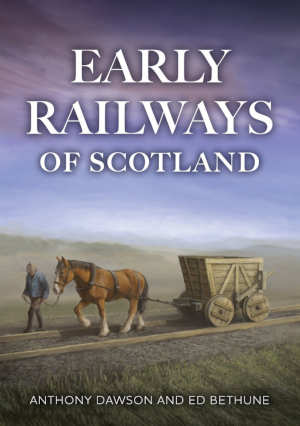Early Railways of Scotland
- Auteurs: Anthony Dawson, Ed Bethune
- Soort boek: Schotse spoorweggeschiedenis
- Taal: Engels
- Uitgever: Amberley Publishing
- Verschijnt: 15 augustus 2025
- Omvang: 96 pagina’s
- Uitgave: paperback
- Prijs: £ 15,99
- Boek bestellen bij: Amazon / Bol / Libris
Anthony Dawson & Ed Bethune Early Railways of Scotland review en recensie
Als er in de media een boekbespreking, recensie of review verschijnt van Early Railways of Scotland, geschreven door Anthony Dawson en Ed Bethune, dan besteden we er op deze pagina aandacht aan.
Flaptekst van het boek over de eerste spoorwegen in Schotland
In this book Ed Bethune and Anthony Dawson from the 1722 Waggonway Project take the reader on a century long tour of the earliest of Scottish railways, beginning in 1722 with the Tranent–Cockenzie Waggonway and ending with the Garnkirk & Glasgow Railway of 1831, the first ‘modern’ railway in Scotland.
Scottish railway history began in 1722 when William Dickson commenced work on the Tranent–Cockenzie Waggonway. Built entirely in wood and designed to carry coal from pits at Tranent to salt pans at Cockenzie, it was the first railway to be built in Scotland. Developing first in the most industrialised parts of the country, in the Lothians and later around Glasgow, wooden and iron railways flourished in no small part thanks to the work of Robert Stevenson.
Ed Bethune and Anthony Dawson of the 1722 Waggonway Project present a century-long tour of the earliest of Scottish railways, beginning in 1722 and ending with the Garnkirk & Glasgow Railway of 1831, the first ‘modern’ railway in Scotland. The 1722 Waggonway Heritage Group was established in 2017 to preserve, promote and enhance the history of the Tranent–Cockenzie Waggonway through research, archaeology and community heritage initiatives. Thanks to the work of the group, much is now known about how early wooden railways were constructed and how early nineteenth-century fish-bellied rails laid on stone blocks worked, as well as the 1833 Robert Stevenson-designed harbour at Cockenzie.
Brand-new information from the archival and archaeological work into Scotland’s earliest railways is showcased alongside fascinating and rare images, all serving to set the scene for the beginnings of the Scottish railway network as conceived by trailblazers William Dickson, William Adam and Robert Stevenson.
